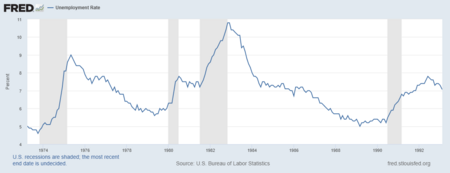History of the United States (1980–1991) facts for kids
| 1980–1991 | |
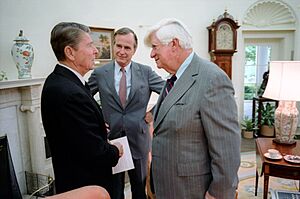
Ronald Reagan, George H. W. Bush, and Tip O'Neill in 1981
|
|
| Preceded by | History of the United States (1964–1980) |
|---|---|
| Including | Reagan Era Late Cold War Third Industrial Revolution |
| Followed by | History of the United States (1991–2008) |
The history of the United States from 1980 to 1991 covers a busy time for America. It includes the last year of President Jimmy Carter's time in office, the eight years of President Ronald Reagan's leadership, and the first three years of President George H. W. Bush's presidency. This period ended when the Soviet Union broke apart.
President Carter faced big challenges like the Iran hostage crisis, rising prices (inflation), and growing opposition at home. Because of these issues, he lost the 1980 United States presidential election to Republican Ronald Reagan.
When Reagan became president, he started new economic plans. These plans aimed to boost the American economy after a tough time in 1981 and 1982. He also met with Soviet leader Mikhail Gorbachev several times. These meetings helped speed up the end of the Cold War, which happened between 1989 and 1991. During this time, communism fell apart in Eastern Europe and the Soviet Union. The economy struggled at first but then grew strongly.
A big event during Reagan's time was the Iran–Contra affair. This was a scandal where the Reagan Administration sold weapons to Iran. The money from these sales was then secretly used to help a group called the Contras in Nicaragua. The Contras were fighting against the government there.
Contents
Carter's Presidency (1980-1981)
Moving to the Sun Belt
During the 1970s, many Americans started moving to the "Sun Belt." This warm region includes the Southwest, Southeast, and especially Florida and California. By 1980, more people lived in the Sun Belt than in the older industrial areas of the Northeast and Midwest. These older areas, sometimes called the "Rust Belt," were losing factories and jobs.
People moved south and west for many reasons. Cheaper air travel, cars, and new highways made it easier to move. Air conditioning also made the warmer states more comfortable. Young workers and retired people especially liked the Sun Belt.
This shift in population also changed American politics. The Sun Belt often supported more conservative ideas. The Rust Belt, with its older industries and less growth, tended to support social programs. This difference showed up in elections. The Northeast and Midwest often voted for Democratic candidates. The South and West became a strong base for the Republican Party.
Tough Times and New Ideas
In the 1970s, events like the Vietnam War and the Watergate scandal made many Americans lose trust in their government. The country also faced challenges around the world. South Vietnam fell in 1975, and the Iran hostage crisis began in 1979. The Soviet Union also sent troops into Afghanistan. These events made people worry about America's place in the world.
At home, the economy was struggling with high unemployment and rising prices. This led to a feeling of "malaise" or a lack of confidence in the country's future.
Meanwhile, the Soviet Union's economy was also having problems. They were behind in technology like computers. The Soviets also tried to spread communism in other parts of the world. For example, they invaded Afghanistan in 1979.
Because of these worries, a group of thinkers and politicians called "neoconservatives" emerged. They believed America needed to be stronger against the Soviet Union. They wanted to actively challenge communism, not just try to get along with it. They felt that earlier policies were too soft.
In 1980, the U.S. Olympic hockey team beat the professional Soviet team in the "Miracle on Ice." This unexpected victory gave Americans a boost of hope and pride.
Ronald Reagan and the 1980 Election
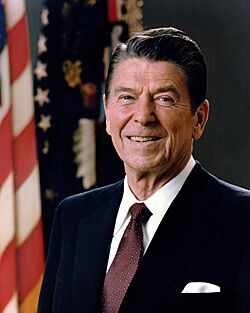
Many Americans felt that liberal government programs weren't working as promised. President Jimmy Carter was running for reelection in 1980. He won his party's nomination but faced a strong challenge from Ronald Reagan. Reagan was the former governor of California.
Reagan promised to make the U.S. military strong again after it had weakened after the Vietnam War. He also promised to reduce the size of government and fix the economy. He supported an idea called "supply-side economics." This idea suggested that cutting taxes, especially for businesses and wealthy people, would encourage them to invest more. This investment, they believed, would create jobs and boost the economy.
Many people, especially in the Sun Belt, liked Reagan's ideas. They voted for him in 1980. Critics worried that his plans would hurt the poor.
The 1980 election was a big moment in American politics. It showed the growing power of the suburbs and the Sun Belt. It also marked a shift away from big government social programs. Reagan won by a large margin, and his Republican Party gained control of the Senate.
Reagan's Presidency (1981-1989)
Ronald Reagan was a popular president. He often let his team handle the daily tasks of government. He focused on big ideas and connected well with the public.
In March 1981, Reagan was shot but recovered quickly. He also made history by appointing the first woman, Sandra Day O'Connor, to the Supreme Court in 1981.
Reaganomics and the Economy
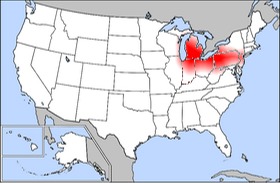
Reagan promised to improve the economy for everyone. His plan, called "Reaganomics," involved cutting taxes and reducing government spending. Some people worried that cutting taxes would mean less money for the government, leading to big deficits. But Reagan and his supporters believed that tax cuts would make the economy grow so much that the government would actually collect more money.
In 1981, Congress passed Reagan's economic laws. These laws included big tax cuts for individuals and businesses. They also increased spending on defense. However, the administration decided not to cut spending on Social Security, a program for retired people.
By 1982, Reagan's economic plan faced problems. The country entered a serious recession, and unemployment reached 10 percent. Some parts of the "Rust Belt" suffered greatly as factories closed. Many family farms also struggled.
Reagan allowed the Federal Reserve (the U.S. central bank) to reduce the money supply to fight inflation. This helped control rising prices but also made the recession worse for a short time. Reagan's approval ratings dropped during this period.
However, the economy began to recover by mid-1983. Oil prices dropped, which helped reduce inflation. Unemployment fell, and the economy started growing again. Reagan called this time "Morning in America." Housing and the auto industry boomed, and people spent more money. But many old factory jobs were gone, and blue-collar workers often didn't see the same benefits.
Reagan was so popular that he won the 1984 United States presidential election by a huge margin, winning 49 out of 50 states.
Rising Government Debt
Even with the economic recovery, the government's debt grew a lot under Reagan. This was because of the tax cuts and the big increase in military spending. The government spent much more than it collected in taxes.
The national debt more than doubled from $749 billion in 1980 to $1.746 trillion in 1986. Since Americans weren't saving much, the U.S. had to borrow a lot of money from other countries. This changed the U.S. from being the world's biggest lender to its biggest borrower.
The high debt also kept interest rates up. This made it harder for businesses to invest and grow. In 1987, the stock market suddenly crashed, but the Federal Reserve acted quickly to prevent a deeper crisis.
The U.S. dollar also became very strong, which made American goods more expensive for other countries to buy. This hurt American industries like cars and steel, as they struggled to compete with cheaper imports, especially from Japan. The American consumer electronics industry also suffered greatly. However, the computer industry grew rapidly during the 1980s.
Reagan and the World
Foreign Policy: Around the Globe
Reagan promised to make the U.S. military strong again. Military spending increased greatly in the 1980s. This led to a new arms race with the Soviet Union.
Reagan's foreign policy was often seen as very successful. He took a tough stance against the Soviet Union, especially in developing countries. Instead of sending large armies, the U.S. supported smaller, specially trained groups to fight against communist movements.
In 1983, U.S. forces were in Beirut, Lebanon, to help bring peace. Sadly, a bombing killed 241 American troops. The U.S. then pulled its soldiers out.
Later in 1983, the U.S. invaded the small Caribbean island of Grenada in an operation called Operation Urgent Fury. A communist group had taken over the government, and many American students were on the island. The U.S. military quickly took control and helped restore democracy.
In 1986, Reagan ordered an air strike against Libya. This was after Libya's leader, Muammar Gaddafi, was linked to a bombing that killed American soldiers in West Berlin.
The Reagan administration also helped governments in El Salvador and Honduras. They supported groups fighting against communist movements in Central America, especially in Nicaragua. The CIA helped organize and fund a group called the Contras in Nicaragua.
This secret funding led to the Iran–Contra affair. In 1985, Reagan approved selling weapons to Iran to try and free American hostages in Lebanon. It was later revealed that some of the money from these sales was illegally sent to the Contras. This scandal hurt Reagan's popularity for a while.
In Afghanistan, Reagan greatly increased aid to the mujahideen fighters. They were fighting against the Soviet-backed government. The U.S. gave them advanced weapons, which helped them push back the Soviets. The Soviet Union eventually pulled its troops out of Afghanistan.
Reagan also supported groups fighting against the Vietnamese-backed government in Cambodia. He continued U.S. support for the leader of the Philippines, Ferdinand Marcos, because Marcos was strongly anti-communist. Marcos was later removed from power by a peaceful movement in 1986.
The End of the Cold War
The Reagan administration took a very firm stand against the Soviet Union. Reagan famously called the Soviet Union the "evil empire." Tensions between the U.S. and the Soviets were very high. Reagan also started a research project called the Strategic Defense Initiative (SDI), nicknamed "Star Wars." This was a plan for a missile defense system that could shoot down Soviet missiles.
Even though the Soviets had some successes in other countries, their economy was struggling. They couldn't keep up with the U.S. in technology or the arms race.
Things started to change when Mikhail Gorbachev became the Soviet leader in 1985. Gorbachev was younger and wanted to reform the Soviet Union. He focused on improving the economy and making the government more open. He realized that the Soviet Union couldn't afford the arms race.
Gorbachev began to make agreements with the U.S. In 1987, the two countries signed a treaty to reduce nuclear weapons. Soviet troops also left Afghanistan. These changes helped lead to the end of the Cold War.
Starting in the late 1980s, communist governments in Eastern Europe began to fall. The "fall of the Berlin Wall" in 1989 was a powerful symbol of this change. The U.S. and Soviet Union's relationship improved greatly. This also encouraged countries like Chile and South Korea to become more democratic.
George H. W. Bush's Presidency (1989-1991)
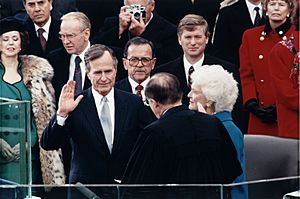
Reagan's Vice President, George H. W. Bush, easily won the 1988 United States presidential election. He defeated Michael Dukakis, the Democratic governor of Massachusetts.
World Events Under Bush
Bush had a lot of experience in foreign affairs. He had been an ambassador and head of the CIA. He focused on careful management of world events.
Many big things happened in the world during Bush's presidency:
- In June 1989, protests in Tiananmen Square in China were stopped by force. This was widely criticized.
- The United States invasion of Panama happened in December 1989 to remove a dictator.
- The U.S. and Soviet Union signed treaties to reduce nuclear weapons.
- The Gulf War began in 1991. Bush led a large group of countries to defeat Iraq after it invaded Kuwait.
- The Cold War ended with the defeat of Soviet communism.
- Communist governments in Eastern Europe collapsed in 1989.
- Germany was reunified in 1990, bringing together the democratic West and the former communist East.
- The dissolution of the Soviet Union in 1991, which broke into 15 separate countries.
Most of these events were good for the United States. Bush took action in Panama and with the nuclear treaties. For other events, he mostly watched without interfering. Experts generally praise Bush's foreign policy.
After the Cold War
Bush spoke about a "new world order." He imagined a world with less terror, more justice, and more peace.
The Baltic States (Lithuania, Estonia, and Latvia) declared independence from the Soviet Union. On December 26, 1991, the Soviet Union officially broke apart. The Cold War was over.
With the Cold War ended, new problems appeared in places like Yugoslavia and Somalia. The U.S. and its allies worked to strengthen international groups like NATO and the International Monetary Fund. They also promoted economic reforms around the world. The North American Free Trade Agreement (NAFTA) was an example of new trade policies.
The U.S. also started to use economic penalties against countries that supported terrorism, tried to get dangerous weapons, or violated human rights.
The Economy Under Bush
When Bush became president, the economy was still strong. However, the Federal Reserve kept money policies tight, which slowed growth. In mid-1990, oil prices rose sharply, and people spent less. The economy then entered a mild recession. Some cities in California and the Northeast were hit hardest, while the South was less affected.
See also
- Reagan Era
- Presidency of George H. W. Bush


